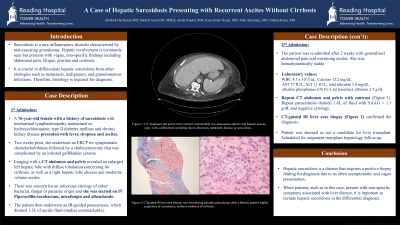Tuesday Poster Session
Category: Liver
P3925 - A Case of Hepatic Sarcoidosis Presenting With Recurrent Ascites Without Cirrhosis
Tuesday, October 24, 2023
10:30 AM - 4:00 PM PT
Location: Exhibit Hall

Has Audio

Abishek Hariharan, MD
Reading Tower Health
Reading, PA
Presenting Author(s)
Shefali Amin, DO, MSEd1, Abishek Hariharan, MD2, Tahminah Kausar, MD3, Anish Paudel, MD4, Jesus Salas Noain, MD3, John Altomare, MD3
1Reading Hospital, Reading, PA; 2Reading Tower Health, Reading, PA; 3Reading Hospital Tower Health, Reading, PA; 4Tower Health-Reading Hospital, Reading, PA
Introduction: Sarcoidosis is a rare inflammatory disorder characterized by non-caseating granulomas. Hepatic lesions must be differentiated from metastasis, malignancy, and granulomatous infections; therefore, histology is necessary for diagnosis. We present a case of atypical isolated hepatic sarcoidosis.
Case Description/Methods: A 76-year-old female with medical history significant for sarcoidosis with mediastinal lymphadenopathy maintained on hydroxychloroquine presented with dyspnea and worsening ascites. She recently had a prolonged hospitalization two months prior for laparoscopic cholecystectomy following ERCP for symptomatic choledocholithiasis that was complicated by an infected gallbladder seroma. Patient was readmitted for fever and CT findings were concerning for residual gallbladder and hepatic abscess as well as new-onset ascites. Her abscess was medically managed, and paracentesis removed 1.3L with unremarkable fluid studies. Repeat CT scan was performed to assess abscess resolution; however, it revealed acute development of innumerable lesions within the liver and spleen of unclear etiology. Differential diagnosis included micro-abscesses, metastatic disease, and sarcoidosis-related granulomas; therefore, biopsy was recommended. Liver mass biopsy returned with nonspecific findings of inflammation, necessitating a repeat biopsy. Patient required two more therapeutic paracenteses prior to her discharge. She returned two weeks later for this present admission hemodynamically stable with admission laboratory values of WBC 4.5 x 10^3/uL, calcium 13.2 mg/dL, AST 37 IU/L, ALT 11 IU/L, total bilirubin 1.0 mg/dL, alkaline phosphatase 676 IU/L (at baseline), and albumin 2.5 g/dL. Paracentesis removed 1.6L with negative cytology and SAAG < 1.1 g/dL. Repeat biopsy of the liver mass returned with non-necrotizing sclerotic granulomas with a fibrotic pattern highly suspicious of sarcoidosis, without evidence of cirrhosis. The diagnosis of hepatic sarcoidosis was confirmed. She was not a candidate for liver transplant given her age and co-morbidities. Patient was medically managed with plans for outpatient hepatology follow-up.
Discussion: Hepatic sarcoidosis is a granulomatous disease of unknown etiology requiring liver biopsy for diagnosis. This case represents an atypical presentation of hepatic sarcoidosis as the patient did not have pulmonary involvement. Recurrent ascites can be a complication of hepatic sarcoidosis. The ultimate treatment is liver transplantation.
Disclosures:
Shefali Amin, DO, MSEd1, Abishek Hariharan, MD2, Tahminah Kausar, MD3, Anish Paudel, MD4, Jesus Salas Noain, MD3, John Altomare, MD3. P3925 - A Case of Hepatic Sarcoidosis Presenting With Recurrent Ascites Without Cirrhosis, ACG 2023 Annual Scientific Meeting Abstracts. Vancouver, BC, Canada: American College of Gastroenterology.
1Reading Hospital, Reading, PA; 2Reading Tower Health, Reading, PA; 3Reading Hospital Tower Health, Reading, PA; 4Tower Health-Reading Hospital, Reading, PA
Introduction: Sarcoidosis is a rare inflammatory disorder characterized by non-caseating granulomas. Hepatic lesions must be differentiated from metastasis, malignancy, and granulomatous infections; therefore, histology is necessary for diagnosis. We present a case of atypical isolated hepatic sarcoidosis.
Case Description/Methods: A 76-year-old female with medical history significant for sarcoidosis with mediastinal lymphadenopathy maintained on hydroxychloroquine presented with dyspnea and worsening ascites. She recently had a prolonged hospitalization two months prior for laparoscopic cholecystectomy following ERCP for symptomatic choledocholithiasis that was complicated by an infected gallbladder seroma. Patient was readmitted for fever and CT findings were concerning for residual gallbladder and hepatic abscess as well as new-onset ascites. Her abscess was medically managed, and paracentesis removed 1.3L with unremarkable fluid studies. Repeat CT scan was performed to assess abscess resolution; however, it revealed acute development of innumerable lesions within the liver and spleen of unclear etiology. Differential diagnosis included micro-abscesses, metastatic disease, and sarcoidosis-related granulomas; therefore, biopsy was recommended. Liver mass biopsy returned with nonspecific findings of inflammation, necessitating a repeat biopsy. Patient required two more therapeutic paracenteses prior to her discharge. She returned two weeks later for this present admission hemodynamically stable with admission laboratory values of WBC 4.5 x 10^3/uL, calcium 13.2 mg/dL, AST 37 IU/L, ALT 11 IU/L, total bilirubin 1.0 mg/dL, alkaline phosphatase 676 IU/L (at baseline), and albumin 2.5 g/dL. Paracentesis removed 1.6L with negative cytology and SAAG < 1.1 g/dL. Repeat biopsy of the liver mass returned with non-necrotizing sclerotic granulomas with a fibrotic pattern highly suspicious of sarcoidosis, without evidence of cirrhosis. The diagnosis of hepatic sarcoidosis was confirmed. She was not a candidate for liver transplant given her age and co-morbidities. Patient was medically managed with plans for outpatient hepatology follow-up.
Discussion: Hepatic sarcoidosis is a granulomatous disease of unknown etiology requiring liver biopsy for diagnosis. This case represents an atypical presentation of hepatic sarcoidosis as the patient did not have pulmonary involvement. Recurrent ascites can be a complication of hepatic sarcoidosis. The ultimate treatment is liver transplantation.
Disclosures:
Shefali Amin indicated no relevant financial relationships.
Abishek Hariharan indicated no relevant financial relationships.
Tahminah Kausar indicated no relevant financial relationships.
Anish Paudel indicated no relevant financial relationships.
Jesus Salas Noain indicated no relevant financial relationships.
John Altomare indicated no relevant financial relationships.
Shefali Amin, DO, MSEd1, Abishek Hariharan, MD2, Tahminah Kausar, MD3, Anish Paudel, MD4, Jesus Salas Noain, MD3, John Altomare, MD3. P3925 - A Case of Hepatic Sarcoidosis Presenting With Recurrent Ascites Without Cirrhosis, ACG 2023 Annual Scientific Meeting Abstracts. Vancouver, BC, Canada: American College of Gastroenterology.
